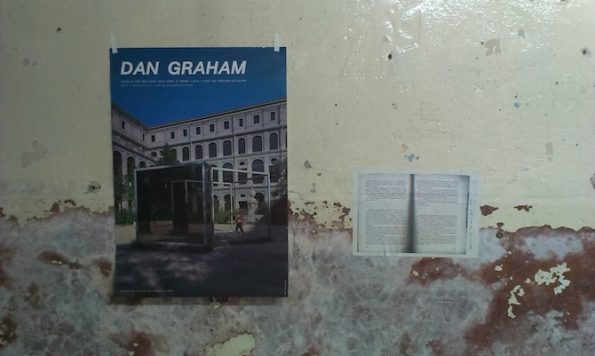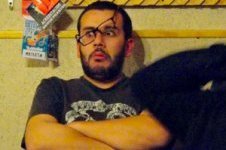Search
To search for an exact match, type the word or phrase you want in quotation marks.
A*DESK has been offering since 2002 contents about criticism and contemporary art. A*DESK has become consolidated thanks to all those who have believed in the project, all those who have followed us, debating, participating and collaborating. Many people have collaborated with A*DESK, and continue to do so. Their efforts, knowledge and belief in the project are what make it grow internationally. At A*DESK we have also generated work for over one hundred professionals in culture, from small collaborations with reviews and classes, to more prolonged and intense collaborations.
At A*DESK we believe in the need for free and universal access to culture and knowledge. We want to carry on being independent, remaining open to more ideas and opinions. If you believe in A*DESK, we need your backing to be able to continue. You can now participate in the project by supporting it. You can choose how much you want to contribute to the project.
You can decide how much you want to bring to the project.

We head down the pronounced slope of the Rúa dos Caldeireiros, a hidden away street that has ended up isolated amidst the process of gentrifying the city of Porto. The street narrows, with the even and odd balconies seeming to touch and in number 77, through a dirty piece of glass and its baroque aluminium grille, we spot an old television out of which glows a video by Dan Graham. Its Rock My Religion, more than just a video, an already historic piece and a bible for the punk-rock trend tied to intellectualism.
Uma certa falta de Coerência is the space that the artists André Sousa and Mauro Cerqueira have been running for the last five years. Through which during this time creators of top class ranking have passed. It is the caprice of two artists that, a few metres further up, also run an old print shop that they have converted into their studio. Uma certa falta de Coerência for them supposes a process of investigation, with each exhibition responding to a new step that their project has to take, on a personal level as well as in the artistic career of each.
Pedro de Llano (Santiago de Compostela, 1977) has been charged with curating this impossible show. The initiative, which emerged out of the friendship that unites Sousa and Cerqueira, arose as a challenge. For de Llano, who first came into contact with Graham in 1996, when the North American gave a workshop at the CGAC (Santiago de Compostela), the idea of working with this artist appealed as a challenge. After the initial doubts, he wrote a letter and sent off the proposal. The aim was to convince Graham of the advantages of bringing his work to this place, a space with very different characteristics to those he was accustomed to. The profound relation that Uma certa falta de Coerência mantains with the urban fabric, architecturally and socially, supposed a point in its favour and Graham accepted the offer.
The customary lack of budget led the artist to propose a series of videos – Two way mirror cylinder inside cube and a video salon, Classic and Recent Installations/Pavilions: 1974-2008 and Death by chocolate, in addition to the aforementioned Rock My Religion- which de Llano, Sousa and Cerqueira decided to complement with other material found in their investigations. This stemmed from the consultation of the archives of the architect Pedro de Llano (the curator’s father) who collaborated with Graham in the design of different pavilions: like the one he made for the terrace of the CGAC, the two projects that resulted in the pavilion of the gardens of the Serralves Foundation (Porto) and two others for MACBA and the Tàpies Foundation that never ended up being built.
The models of Pedro de Llano and the documents corresponding to the process were placed in a way that evaded the fever for the documentary: photocopying and sticking all the sheets in the form of a poster on the space walls: improvised plinths on which rest the models and the crumbling walls onto which the videos are projected. The Coerência is a decrepit, dirty space that returns Graham to this sense of the underground that the white cube will never have. Because Rock & Roll between white walls is an imposture and we know it.
To this material is added the maquette that Graham made as a sketch for the granite sculpture for the Illa das Esculturas in the city of Pontevedra –a place well worth visiting, where since 1999 a series of site specific works (curated by X. Antón Castro) by artists like Richard Long, Robert Morris, Giovanni Anselmo, Ian Hamilton, José Pedro Croft, Jenny Holzer and Ulrich Rückriem coexist in a state of abandon.
There is also this sort of road trip that Sousa, Cerqueira and de Llano have carried out in the last few months, following Graham wherever they knew of his presence, doing interviews and visiting, amongst others, a curious pavilion that the artist projected for a private collection in Extremadura. The pavilion, never contemplated in situ by the artist, opened up the possibility for Graham to travel to Oporto for this show in the Coerência and to thereby take the opportunity to contemplate his piece in Villanueva de la Vera (Cáceres). Sousa, de Llano and Cerqueira had no doubts about travelling to this place, at the foot of the Sierra de Gredos, to film it and place the material at the disposition of the artist.
The project of Coerência as much as Future és Dan Graham, the name they have given to this atypical exhibition, are a perfect example that neither the crisis nor the destructive desires of the cultural policies, whatever their colour, can shift us from the place we occupy. And if it pisses them off so much, let them roll up their trousers and come on down to the sewers.

Ángel Calvo Ulloa was born in a very small place full of vile characters. In the faculty where he studied nobody ever talked to him about criticism or curating, so now he dedicates his time to reading, writing and every now and again doing the odd exhibition. He loves travelling and feeling very small in a large city. He also loves going back home and once again hating this tiny place.
"A desk is a dangerous place from which to watch the world" (John Le Carré)